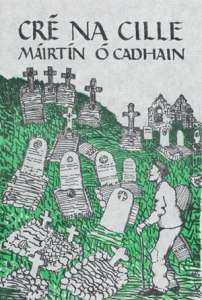Cré na Cille
Cré na Cille is an Irish language novel by Máirtín Ó Cadhain. It was first published in 1949. It is considered one of the greatest novels written in the Irish language.[1]
 | |
| Author | Máirtín Ó Cadhain |
|---|---|
| Translator | Alan Titley Liam Mac Con Iomaire and Tim Robinson |
| Country | Ireland |
| Language | Irish |
| Publisher | Sáirséal agus Dill, Yale University Press Cló Iar-Chonnacht |
Publication date | 1949 |
Published in English | 2016 |
| Media type | |
| Pages | 364 |
| OCLC | 2674025 |
| 891.6284 | |
| LC Class | PB1399 .O28 |
Title
Cré na Cille [cɾʲeː nˠə ˈcɪlʲə] literally means "Earth of the Church"; it has also been translated as Graveyard Clay[2], Graveyard Soil[3], Graveyard Earth[4], Church and Clay[5] and The Dirty Dust[6].
Overview
The novel is written almost entirely as conversation between the dead in a Connemara graveyard. The talk is full of gossip, backbiting, flirting, feuds, and scandal-mongering.[7]
Reception
The novel is considered a masterpiece of 20th Century Irish literature and has drawn comparisons to the work of Flann O’Brien, Samuel Beckett and James Joyce.[8][9] In its serialised form, Cré na Cille was read aloud and gained classic status among Irish speakers.[10][11] Cian Ó hÉigeartaigh, co-author of Sáirséal agus Dill, 1947-1981, claims that it invigorated the revival of Irish language writing in the 20th Century.[12]
Publication History
Cré na Cille was serialised by the newspaper The Irish Press and then published by Sáirséal agus Dill in 1949.[13]
It was translated into Norwegian by Professor Jan Erik Rekdal and published in 1995 by Gyldendal Norsk Forlag as Kirkegårdsjord - gjenfortellinger i ti mellomspill, and translated into Danish by Ole Munch-Pedersen and published in 2000 by Husets Forlag as Kirkegårdsjord - genfortælling i ti mellemspil.[14][15]
Two English translations of the novel were published in 2016 by Yale University Press and Cló Iar-Chonnacht. The first translation, The Dirty Dust, is by Professor Alan Titley, the second, Graveyard Clay, by Liam Mac Con Iomaire and the British cartographer Tim Robinson.
The lack of an English translation for such a long period of time after the book’s first publication became part of its renown and was a matter of speculation.[16] Three early attempts at translation by Sáirséal agus Dill were thwarted, the first when the young woman selected as the translator joined a convent, the second by the refusal of the poet Thomas Kinsella and the third by an unsatisfactory effort by a former prison-mate of Ó Cadhain’s.[17]
Media Adaptations
Radio
A dramatised version of the novel was broadcast on RTÉ Raidió na Gaeltachta in 1973, and was revised and rebroadcast in 2006 as part of RTÉ’s Ó Cadhain centenary celebrations.[18]
Theatre
The novel was adapted for the stage by Macdara Ó Fátharta and was performed in 1996 and 2006.[19][20] The role of Caitríona Pháidín was played by Bríd Ní Neachtain. The action was dramatised “in a cavernous space, with characters appearing from alcoves to interact with Caitríona, before slowly drifting back into the dimly lit set - reminding us that these people are gradually merging with the graveyard clay”.[21] Bríd Ní Neachtain was nominated for an Irish Times Theatre Award for her performance in the play.[22]
Film
A film adaptation, directed by Robert Quinn, was released in 2007. Like the stage play, it was written by Macdara Ó Fatharta and starred Bríd Ní Neachtain.[23]
References List
- Kiberd, Declan (2001). Irish Classics. Cambridge, Massachusetts: Harvard University Press. ISBN 9780674005051.
- "Graveyard Clay/Cré na Cille review: New lease of life for Irish classic".
- "Cré Na Cille le Máirtín Ó Cadhain".
- https://www.tcd.ie/Secretary/FellowsScholars/discourses/discourses/2002_C%20O%20Hainle%20on%20M%20O%20Cadhain.pdf
- State, Paul F. (3 November 2018). A Brief History of Ireland. Infobase Publishing. ISBN 9780816075164 – via Google Books.
- "The Dirty Dust Cré na Cille (Paperback Edition) - CIC". www.cic.ie.
- Yale University Press (17 March 2016). "Graveyard Clay: Cré na Cille". Yale University Press. Retrieved 21 February 2017.
- Brennan, William (17 March 2016). "The Irish Novel That's So Good People Were Scared to Translate It". The New Yorker. Retrieved 21 February 2017.
- Kiberd, Declan (15 February 2006). "No Ordinary Man". Irish Examiner.
- Ó Cadhain, Máirtín (2016). "Translator's Introduction". The Dirty Dust: Cré na Cille. Translated by Titley, Alan. New Haven: Yale University Press. pp. ix–x. ISBN 9780300198492.
- Glucksman Ireland House NYU (5 May 2015). "U.S. launch of The Dirty Dust with Alan Titley, Colm Tóibín, & Brian Ó Conchubhair at GIH NYU". YouTube. Retrieved 21 February 2017.
- RTÉ Radio 1 (9 February 2015). "Arts Tonight". RTÉ. Retrieved 21 February 2017.
- NcEoin, Mairin; O'Tool, Fintan (4 July 2015). "Modern Ireland in 100 Artworks: 1949 – Cré na Cille, by Máirtín Ó Cadhain". The Irish Times. Retrieved 21 February 2017.
- Kirkegardsjord : genfortaelling i ti mellemspil. OCLC 810733488.
- Kirkegårdsjord : gjenfortellinger i ti mellomspill. OCLC 46656985.
- "Giving nothing away". The Irish Times. 27 May 2000. Retrieved 21 February 2017.
- Cronin, Michael (7 April 2001). "It's time for Cre na Cille in English". The Irish Times. Retrieved 21 February 2017.
- RTÉ Radio 1 (29 March 2012). "Cré Na Cille le Máirtín Ó Cadhain". RTÉ. Retrieved 22 February 2017.
- Abbey Theatre. "Cré na Cille 1996 (Tour)". Abbey Theatre. Retrieved 22 February 2017.
- "Going back to the plot". The Irish Times. 12 August 2006. Retrieved 22 February 2017.
- Lonergan, Patrick (31 July 2006). "Reviews". The Irish Times. Retrieved 22 February 2017.
- Irish Film Board (1 December 2010). "DVD of film adaptation of celebrated Irish language novel 'Cré na Cille' now available to buy". Irish Film Board. Archived from the original on 23 February 2017. Retrieved 22 February 2017.
- RTÉ (29 May 2007). "Cré na Cille shortlisted at Shanghai Film Fest". RTÉ. Retrieved 22 February 2017.